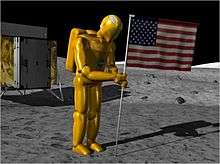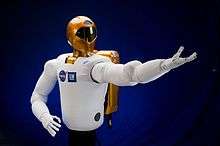Project M (NASA)


Project M was a proposed NASA project headed by Stephen J. Altemus, to send a Robonaut to the Moon.[1] This was hoped to be achieved in just 1000 days from the official go ahead. Project M has since been scaled down into Project Morpheus.[2]
A Quad prototype lander has been built in partnership with Armadillo Aerospace.[3]
History
NASA projected the project could have cost less than $200 million. An additional $250 million would have been needed for the launch vehicle. The project could have been accomplished in a thousand days or less once it had been approved. The project would have used a variation of lander developed by Armadillo Aerospace.[1][4]
The June 23rd 2010 flight carried a prototype GENIE (Guidance Embedded Navigator Integration Environment). GENIE was developed to demonstrate fully functional, real-time, guidance, navigation, and control (GNC) code in a terrestrial rocket vehicle applicable to landing on the surface of the Moon.[5]
References
- 1 2 "At NASA, a Quiet Quest to Send a Humanoid Robot to the Moon". New York Times. November 1, 2010. Retrieved 2010-11-01.
The idea, known as Project M, is almost a guerrilla effort within NASA, cooked up a year ago by Stephen J. Altemus, the chief engineer at Johnson. He tapped into discretionary money, pulled in engineers to work on it part time, and horse-traded with companies and other NASA units to undertake preliminary planning and tests.
- ↑ Boyle, Alan (2011-07-01). "Inside NASA's 'Skunk Works' lab". MSNBC. Retrieved 16 July 2011.
Project Morpheus started out as "Project M," a concept that called for landing a humanoid robot on the moon in 1,000 days. Then reality set in, and the project was redefined.
- ↑ http://robonaut.jsc.nasa.gov/future/HistoryandPhilosophy/#continued
- ↑ "NASA's Madcap Sci-Fi Plan Could Get an Android Moonwalking Within 3 Years". Fast Company. May 19, 2010. Retrieved 2010-11-01.
- ↑ NASAProjectM. "Project M GENIE Integration and Lander Free Flight". YouTube. Retrieved November 24, 2012.